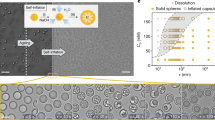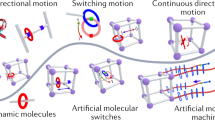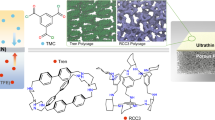Abstract
The sorption of species from a solution into and onto solids underpins the sequestering of waste and pollutants, precious metal recovery, heterogeneous catalysis, analysis and separation science, and other technologies1,2. The transfer between phases tends to proceed spontaneously in the direction of equilibrium. For example, alkyl ammonium groups mounted on silica nanoparticles are used to chemisorb cucurbituril macrocycles from solution through host–guest binding3,4. Molecular ratchet mechanisms5,6,7, in which kinetic gating8,9,10,11,12 inhibits or accelerates particular steps, makes it possible to progressively drive dynamic systems13,14,15,16 away from equilibrium17,18,19,20,21. Here we report on molecular pumps22 immobilized on polymer beads23,24,25 that use an energy ratchet mechanism5,9,19,20,21,26,27,28,29,30 to directionally transport substrates from solution onto the beads. On the addition of trichloroacetic acid (CCl3CO2H)19,31,32,33 fuel19,34,35,36,37, micrometre-diameter polystyrene beads functionalized38 with solvent-accessible molecular pumps sequester from the solution crown ethers appended with fluorescent tags. After fuel consumption, the rings are mechanically trapped in a higher-energy, out-of-equilibrium state on the beads and cannot be removed by dilution or exhaustive washing. This differs from dissipative assembled materials11,13,14,15,16, which require a continuous supply of energy to persist, and from conventional host–guest complexes. The addition of a second fuel pulse causes the uptake of more macrocycles, which drives the system further away from equilibrium. The second macrocycle can be labelled with a different fluorescent tag, which confers sequence information39 on the absorbed structure. The polymer-bound substrates can be released back to the bulk either one compartment at a time or all at once. Non-equilibrium40 sorption by immobilized artificial molecular machines41,42,43,44,45 enables the transduction of energy from chemical fuels for the use, storage and release of energy and information.
This is a preview of subscription content, access via your institution
Access options
Access Nature and 54 other Nature Portfolio journals
Get Nature+, our best-value online-access subscription
$29.99 / 30 days
cancel any time
Subscribe to this journal
Receive 12 print issues and online access
$259.00 per year
only $21.58 per issue
Buy this article
- Purchase on Springer Link
- Instant access to full article PDF
Prices may be subject to local taxes which are calculated during checkout





Similar content being viewed by others
Data availability
The data that support the findings of this study are available within the article and its Supplementary Information.
References
Yang, Y.-W., Sun, Y.-L. & Song, N. Switchable host–guest systems on surfaces. Acc. Chem. Res. 47, 1950–1960 (2014).
Kolesnichenko, I. V. & Anslyn, E. V. Practical applications of supramolecular chemistry. Chem. Soc. Rev. 46, 2385–2390 (2017).
Nguyen, T. D. et al. A reversible molecular valve. Proc. Natl Acad. Sci. USA 102, 10029–10034 (2005).
Yang, Y.-W. Towards biocompatible nanovalves based on mesoporous silica nanoparticles. Med. Chem. Commun. 2, 1033–1049 (2011).
Kay, E. R., Leigh, D. A. & Zerbetto, F. Synthetic molecular motors and mechanical machines. Angew. Chem. Int. Ed. 46, 72–191 (2007).
Zhang, L., Marcos, V. & Leigh, D. A. Molecular machines with bio-inspired mechanisms. Proc. Natl Acad. Sci. USA 115, 9397–9404 (2018).
Astumian, R. D. et al. Non-equilibrium kinetics and trajectory thermodynamics of synthetic molecular pumps. Mater. Chem. Front. 4, 1304–1314 (2020).
Astumian, R. D. Irrelevance of the power stroke for the directionality, stopping force, and optimal efficiency of chemically driven molecular machines. Biophys. J. 108, 291–303 (2015).
Erbas-Cakmak, S., Leigh, D. A., McTernan, C. T. & Nussbaumer, A. L. Artificial molecular machines. Chem. Rev. 115, 10081–10206 (2015).
Astumian, R. D., Mukherjee, S. & Warshel, A. The physics and physical chemistry of molecular machines. ChemPhysChem 17, 1719–1741 (2016).
Amano, S., Fielden, S. D. P. & Leigh, D. A. A catalysis-driven artificial molecular pump. Nature 594, 529–534 (2021).
Borsley, S., Leigh, D. A. & Roberts, B. M. W. A doubly kinetically-gated information ratchet autonomously driven by carbodiimide hydration. J. Am. Chem. Soc. 143, 4414–4420 (2021).
Boekhoven, J., Hendriksen, W. E., Koper, G. J. M., Eelkema, R. & van Esch, J. H. Transient assembly of active materials fueled by a chemical reaction. Science 349, 1075–1079 (2015).
De, S. & Klajn, R. Dissipative self-assembly driven by the consumption of chemical fuels. Adv. Mater. 30, 1706750 (2018).
van Rossum, S. A. P., Tena-Solsona, M., van Esch, J. H., Eelkema, R. & Boekhoven, J. Dissipative out-of-equilibrium assembly of man-made supramolecular materials. Chem. Soc. Rev. 46, 5519–5535 (2017).
Ragazzon, G. & Prins, L. J. Energy consumption in chemical fuel-driven self-assembly. Nat. Nanotechnol. 13, 882–889 (2018).
Serreli, V., Lee, C.-F., Kay, E. R. & Leigh, D. A. A molecular information ratchet. Nature 445, 523–527 (2007).
Cheng, C. et al. An artificial molecular pump. Nat. Nanotechnol. 10, 547–553 (2015).
Erbas-Cakmak, S. et al. Rotary and linear molecular motors driven by pulses of a chemical fuel. Science 358, 340–343 (2017).
Pezzato, C. et al. Controlling dual molecular pumps electrochemically. Angew. Chem. Int. Ed. 57, 9325–9329 (2018).
Qiu, Y. et al. A precise polyrotaxane synthesizer. Science 368, 1247–1253 (2020).
Qiu, Y., Feng, Y., Guo, Q.-H., Astumian, R. D. & Stoddart, J. F. Pumps through the ages. Chem 6, 1952–1977 (2020).
Balzani, V., Credi, A. & Venturi, M. Molecular machines working on surfaces and at interfaces. ChemPhysChem 9, 202–220 (2008).
Davis, J. J., Orlowski, G. A., Rahman, H. & Beer, P. D. Mechanically interlocked and switchable molecules at surfaces. Chem. Commun. 46, 54–63 (2010).
Zhang, Q. & Qu, D.-H. Artificial molecular machine immobilized surfaces: a new platform to construct functional materials. ChemPhysChem 17, 1759–1768 (2016).
Astumian, R. D. & Derényi, I. Fluctuation driven transport and models of molecular motors and pumps. Eur. Biophys. J. 27, 474–489 (1998).
Hernández, J. V., Kay, E. R. & Leigh, D. A. A reversible synthetic rotary molecular motor. Science 306, 1532–1537 (2004).
Chatterjee, M. N., Kay, E. R. & Leigh, D. A. Beyond switches: ratcheting a particle energetically uphill with a compartmentalized molecular machine. J. Am. Chem. Soc. 128, 4058–4073 (2006).
Barrell, M. J., Campaña, A. G., von Delius, M., Geertsema, E. M. & Leigh, D. A. Light-driven transport of a molecular walker in either direction along a molecular track. Angew. Chem. Int. Ed. 50, 285–290 (2011).
Kassem, S., Lee, A. T. L., Leigh, D. A., Markevicius, A. & Solà, J. Pick-up, transport and release of a molecular cargo using a small-molecule robotic arm. Nat. Chem. 8, 138–143 (2016).
Biagini, C. et al. Dissipative catalysis with a molecular machine. Angew. Chem. Int. Ed. 58, 9876–9880 (2019).
Olivieri, E., Quintard, G., Naubron, J.-V. & Quintard, A. Chemically fueled three-state chiroptical switching supramolecular gel with temporal control. J. Am. Chem. Soc. 143, 12650–12657 (2021).
Abe, Y. et al. Thermoresponsive shuttling of rotaxane containing trichloroacetate ion. Org. Lett. 14, 4122–4125 (2012).
Berrocal, J. A., Biagini, C., Mandolini, L. & Di Stefano, S. Coupling of the decarboxylation of 2-cyano-2-phenylpropanoic acid to large-amplitude motions: a convenient fuel for an acid-base-operated molecular switch. Angew. Chem. Int. Ed. 55, 6997–7001 (2016).
Ghosh, A., Paul, I., Adlung, M., Wickleder, C. & Schmittel, M. Oscillating emission of [2]rotaxane driven by chemical fuel. Org. Lett. 20, 1046–1049 (2018).
Shiab, Q. & Chen, C.-F. Step-by-step reaction-powered mechanical motion triggered by a chemical fuel pulse. Chem. Sci. 10, 2529–2533 (2019).
Biagini, C. & Di Stefano, S. Abiotic chemical fuels for the operation of molecular machines. Angew. Chem. Int. Ed. 59, 8344–8354 (2020).
Asthana, D. et al. Decorating beads with paramagnetic rings: synthesis of inorganic-organic [1014]rotaxanes as shown by spin counting. Preprint at https://chemrxiv.org/engage/chemrxiv/article-details/62019a0ba6fb4d98af4e3aea (2022).
Fuller, A.-M. L., Leigh, D. A. & Lusby, P. J. Sequence isomerism in [3]rotaxanes. J. Am. Chem. Soc. 132, 4954–4959 (2010).
van Esch, J. H., Klajn, R. & Otto, S. Chemical systems out of equilibrium. Chem. Soc. Rev. 46, 5474–5475 (2017).
Berná, J. et al. Macroscopic transport by synthetic molecular machines. Nat. Mater. 4, 704–710 (2005).
Zhu, K. L., O’Keefe, C. A., Vukotic, V. N., Schurko, R. W. & Loeb, S. J. A molecular shuttle that operates inside a metal–organic framework. Nat. Chem. 7, 514–519 (2015).
Martinez-Bulit, P., Stirk, A. J. & Loeb, S. J. Rotors, motors, and machines inside metal–organic frameworks. Trends Chem. 1, 588–600 (2019).
Danowski, W. et al. Unidirectional rotary motion in a metal–organic framework. Nat. Nanotechnol. 14, 488–494 (2019).
Krause, S. & Feringa, B. L. Towards artificial molecular factories from framework-embedded molecular machines. Nat. Rev. Chem. 4, 550–562 (2020).
Wilson, M. R. et al. An autonomous chemically fuelled small-molecule motor. Nature 534, 235–240 (2016).
Coutrot, F. A focus on triazolium as a multipurpose molecular station for pH-sensitive interlocked crown-ether-based molecular machines. ChemistryOpen 4, 556–576 (2015).
Liang, L. & Astruc, D. The copper(I)-catalyzed alkyne–azide cycloaddition (CuAAC) ‘click’ reaction and its applications. An overview. Coord. Chem. Rev. 255, 2933–2945 (2011).
Walsh, C. T., Tu, B. P. & Tang, Y. Eight kinetically stable but thermodynamically activated molecules that power cell metabolism. Chem. Rev. 118, 1460–1494 (2018).
Amano, S., Borsley, S., Leigh, D. A. & Sun, Z. Chemical engines: driving systems away from equilibrium through catalyst reaction cycles. Nat. Nanotechnol. 16, 1057–1067 (2021).
Ardagh, M. A., Birol, T., Zhang, Q., Abdelrahman, O. A. & Dauenhauer, P. J. Catalytic resonance theory: superVolcanoes, catalytic molecular pumps, and oscillatory steady state. Catal. Sci. Technol. 9, 5058–5076 (2019).
Feng, L. et al. Active mechanisorption driven by pumping cassettes. Science 374, 1215–1221 (2021).
Acknowledgements
We thank S. Webb and D. Heyes for assistance with the fluorescence microscopy and spectroscopy, S. D. P. Fielden for useful discussions, the University of Manchester Mass Spectrometry Service Centre for high-resolution mass spectrometry, the Engineering and Physical Sciences Research Council (EPSRC; EP/P027067/1) and the EU (European Research Council (ERC); Advanced grant number 786630) for funding, the University of Manchester for a President’s Scholarship (to D.T.), Marie Skłodowska-Curie Actions of the European Union (individual postdoctoral fellowship 892035 to Y.R.) and J. F. Stoddart for the advanced disclosure of Feng et al.52. D.A.L. is a Royal Society Research Professor.
Author information
Authors and Affiliations
Contributions
D.T., D.J.T., Y.R., S.K. and U.K. planned and carried out the experimental work and characterization studies. D.A.L. directed the research. All authors contributed to the analysis of the results and the writing of the manuscript.
Corresponding author
Ethics declarations
Competing interests
The authors declare no competing interests.
Peer review
Peer review information
Nature Nanotechnology thanks Ying-Wei Yang and the other, anonymous, reviewer(s) for their contribution to the peer review of this work.
Additional information
Publisher’s note Springer Nature remains neutral with regard to jurisdictional claims in published maps and institutional affiliations.
Supplementary information
Supplementary Information
Supplementary Figs. 1–21, Schemes 1–10 and Spectra 1–75.
Rights and permissions
About this article
Cite this article
Thomas, D., Tetlow, D.J., Ren, Y. et al. Pumping between phases with a pulsed-fuel molecular ratchet. Nat. Nanotechnol. 17, 701–707 (2022). https://doi.org/10.1038/s41565-022-01097-1
Received:
Accepted:
Published:
Issue Date:
DOI: https://doi.org/10.1038/s41565-022-01097-1
This article is cited by
-
Artificial molecular pumps
Nature Reviews Methods Primers (2024)
-
Ratcheting synthesis
Nature Reviews Chemistry (2023)
-
A tape-reading molecular ratchet
Nature (2022)
-
Controlling dynamics in extended molecular frameworks
Nature Reviews Chemistry (2022)



